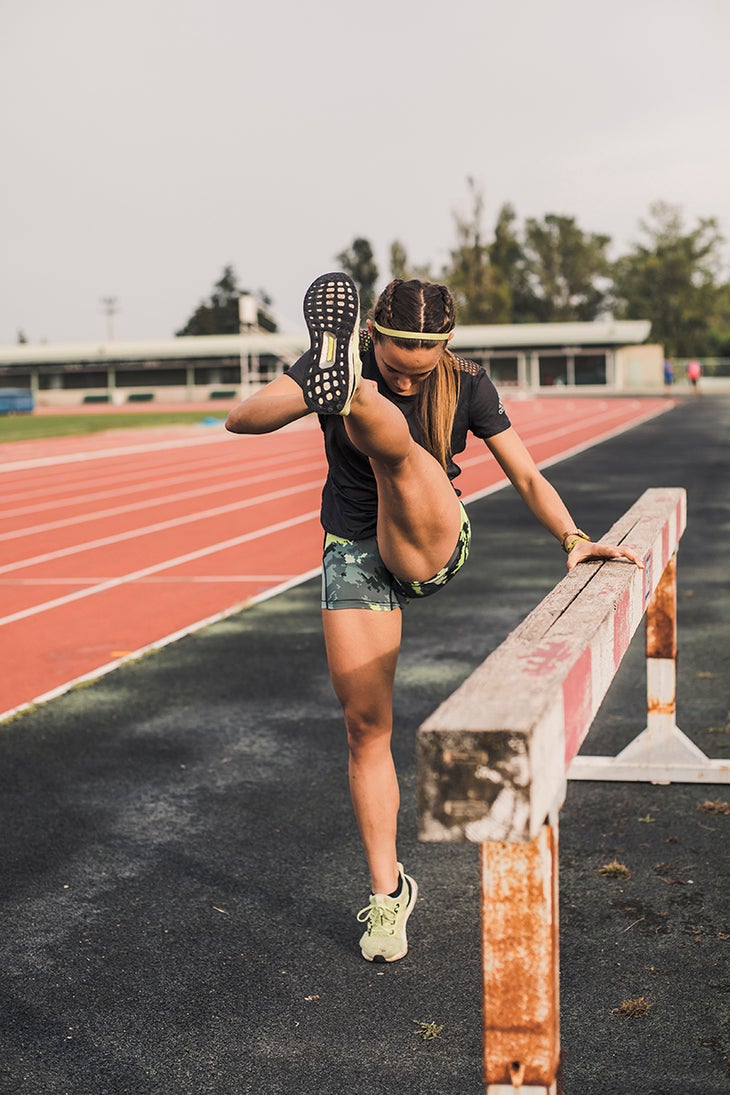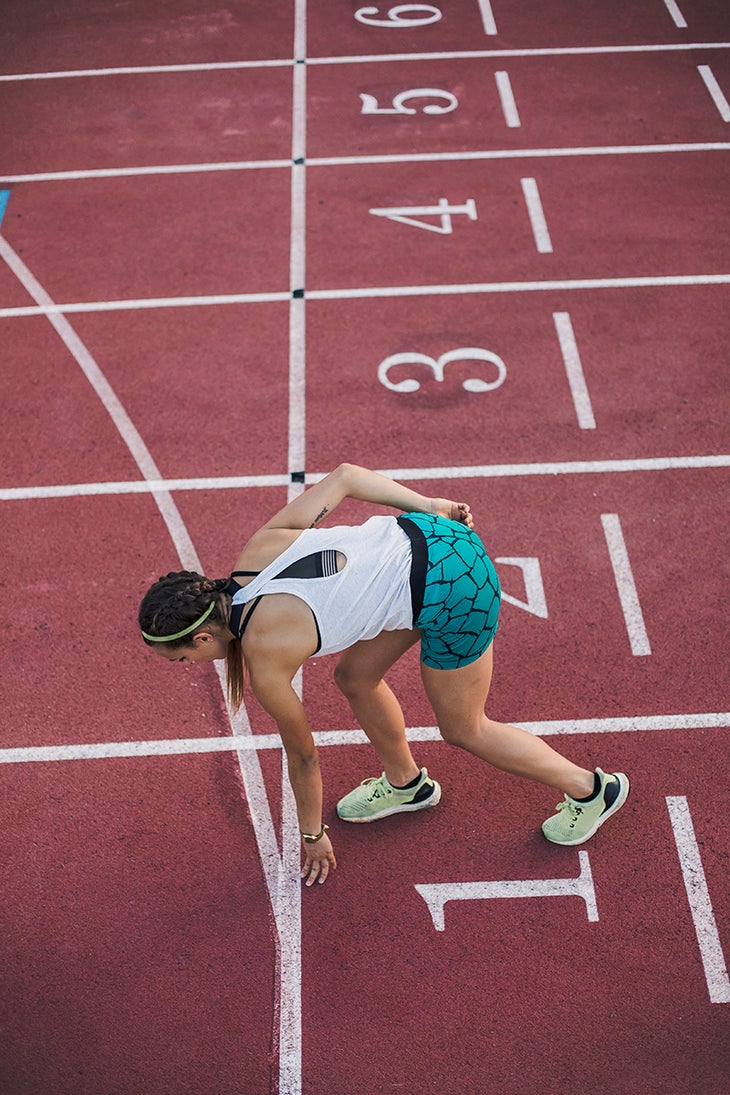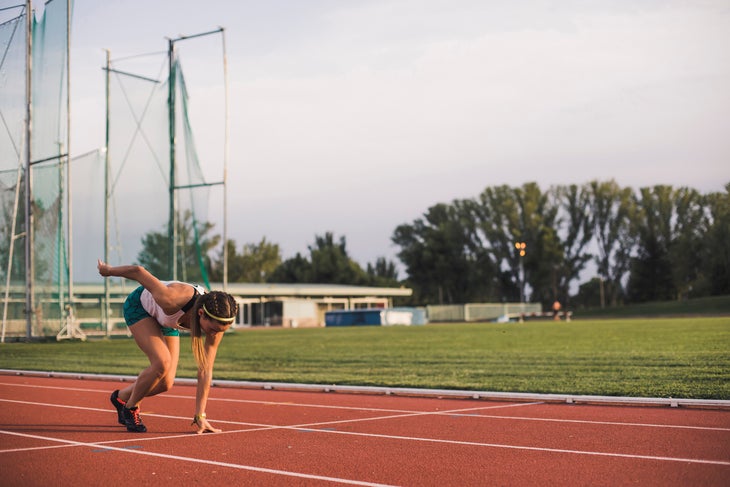Products You May Like
Track workouts are an excellent way to get in speed or interval work with built-in distance measuring and a nice flat surface. But if you’ve never been to a track before, it may be intimidating to hit the lanes for the first time. But it’s worth it: “Track workouts are my absolute favorite,” says Jamie Morrissey, runner for Atalanta NYC.
We’ve collected tips from Morrissey and her teammate Aoibhe Richardson on how to have a successful track workout—plus, six (!) of their favorite track workouts.
How to Have a Great Track Workout
Follow these tips and you’ll have a fun and safe time on the track.
Warming Up is Super Important

The track is the place to ask your body to run faster than usual, so warming up is essential. “For a long run or tempo you might be able to do a minimal warm-up, but for the track I would always recommend doing some drills and strides before getting underway,” says Richardson.
Richardson suggests one or two 200-meter runs (that’s halfway around a normal 400-meter track) at whatever pace you’re aiming for in your workout. She says it helps to get a sense of what the pace feels like and to make sure you’re fully warmed up before starting the first “real” rep.
Morrissey likes to go through a full set of plyometrics and active dynamic drills, as well as some strides, to prime the body for the session.
RELATED: Plyometrics Workout with Alysia Montaño
Track Etiquette
If you’re working out on a public track, there’s likely to be people there doing all sorts of workouts—and there’s some important etiquette to know, mostly about lane one (the inside lane).
“It’s important to always be mindful of other workouts going on around you, and when you are recovering between reps or finishing a rep, make sure not to hang out in lane one,” says Richardson. “Sometimes there might be walkers in lane one (which isn’t ideal!) but I find that if you ask them nicely they will usually move to an outside lane.”

Morrissey agrees about the importance of lane one: “Te biggest thing to remember when you’re on a track is to leave lane one open to anyone who may be going faster than you,” she says. “I’ve accidentally collided with one too many joggers with headphones in, so just be aware of your surroundings and be courteous of everyone trying to get their workout in—manners matter!”
RELATED: Running Etiquette Is Simple: Let’s Be Kind
Track with Friends
The dynamic nature of the track makes it easy to accommodate different goals, meaning you can hit the track for a workout with partners who are at different spots in their training.
“Jamie is a 1500 meter runner and I am a 10k runner, but we still manage to overlap our workouts and do most of the work together where possible,” says Richardson. For the Atalanta runners, this could look like: together they do five 1K reps, then Morrissey does some faster 400s and 200s, and Richardson does three more 1Ks. If you are working out with friends who are at various different levels in their running, some people can do shorter reps with slightly longer recoveries and others can carry on and do longer efforts.
Morrissey likes having friends to help pace. “If you have friends or training partners that are kind enough to pace you, you have some really amazing friends!” she says. “Trusting your training partners to pull you through the appropriate pace can help make your workout less stressful. It allows you to turn your brain off and just run.”
RELATED: Track Tuesday: Tabatas With Friends
Mental Prep
The two athletes biggest advice when it comes to mentally preparing yourself for a track workout is to not get ahead of yourself.
“The biggest mental trick I use is to just take it one rep at a time,” says Morrissey. “It can be daunting if you think about how you’re only on the second 800 of 10, but if you have shorter goals within the workout—like hitting the paces for that specific rep—it can fly by much easier.”
“As with any workout, ease into it,” says Richardson. “Many people get on a track and think that they suddenly need to run at an all-out effort. But this won’t be fun, and will probably mean you will hit a wall halfway through the workout.” She suggests aiming to start out slower than your target race pace and work into it, so that by the end of the workout you can finish with some speedy 400s or 200s and feel good.”
Atalanta’s Favorite Track Workouts for Beginners
Need a plan before you hit the loop? Try one of these six workouts.
1. Speed Ladder

Some combination of intervals starting shorter, building up in distance, and then coming down again. Morrissey’s personal favorite is 200-400-600-800-600-400-200 (meters). The shortest ladder she’s done is 50-100-150-200-150-100-50—”pure speed and so so fun.”
“The longest ladder I’ve done is 1K-2K-3K-2K-1K and I thought it would never end, but by the time the longest rep comes, the workout already seems to be done!”
2. Time Trials/Speed Endurance
A really fun way to test where your fitness is at is to create a race-like situation in practice. This is an all-out effort just to see how much you can push yourself without all the hype of a race day. One of Morrissey’s favorite performance tests is doing an 800 at mile race pace and then taking full recovery and then doing an all-out 800. Or 3 x 400 meters, all at 800 race pace!
3. “The Michigan”
This is both Morrissey’s favorite and least favorite. “It’s obviously my favorite because it was named after the best University in the World [her alma mater], but it’s my least favorite because it was actually a workout designed for 10K runners,” she says.
The traditional version of this workout starts with a mile on the track, then a 2K tempo loop around the Big House (Michigan Stadium), 1200 on the track, 2K tempo, 800 track, 2K tempo, 400 track AUG (All U Got). “I love this workout because it’s gritty. It shows you that you can still run fast on tired legs and it proves that middle distance runners can be good at strength work too!”
4. The Cutdown
“As a 10K runner, a common workout I do is a 2K cutdown, where each rep is one lap shorter than the previous one,” says Richardson. It consists of 2K, 1600, 1200, 800, 400, 200 (or 5, 4, 3, 2, 1, 0.5 laps). The goal is to cut down the pace with the distance, so the 2K would be threshold pace (should feel pretty controlled), and the last two reps should feel fast. Richardson usually takes 90 seconds and 2 minutes rest.
“I love a workout where the reps get progressively shorter and faster as they always make me feel good,” she says.
5. Ins and Outs/Wind Sprints
This is a really simple workout but is a great one for easing into track work. For this workout you simply stride/sprint the straights on the track and jog the bends for an allotted number of laps. Four to five laps is usually a good start, and the “sprint” portions should be controlled enough that you can continue to run the entire time.
6. 800 Pace Change
For this workout, the 800s are broken into sets of two reps, where the first rep is done at a controlled threshold the pace, and the second rep is slightly faster (and gets progressively faster as the session progresses). This is a good way to practice changing pace like you would in a race. Richardson usually does around 5 sets, with 60 seconds between the two reps in a set and 2:30 between sets.
RELATED: 3 Classic Track Workouts for Runners
